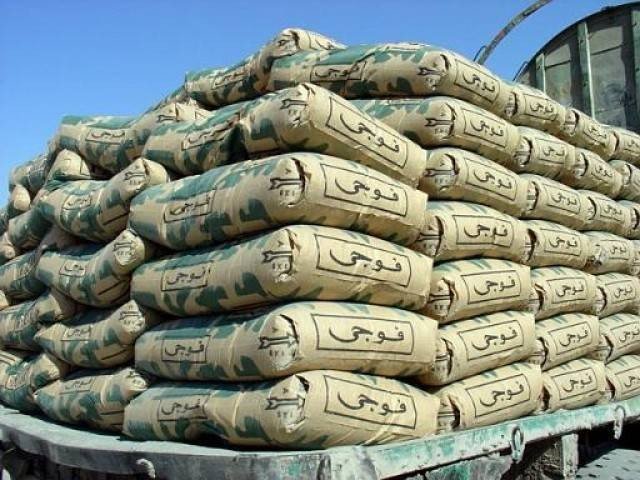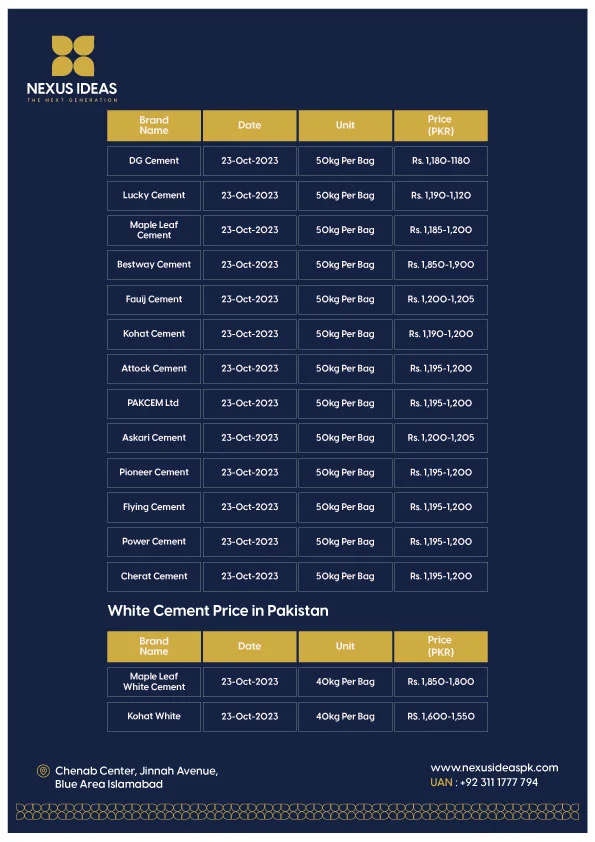Cement prices in Pakistan fluctuate daily. Staying updated is crucial for both builders and buyers.
Cement is a vital component in construction. Its cost impacts overall project budgets and timelines. Understanding the current rates can help you make informed decisions. Whether you’re a contractor planning a big project or a homeowner looking to do some renovations, knowing the cement rate today is important.
Prices can vary due to several factors, including demand, supply chain issues, and economic conditions. By keeping track of these changes, you can better manage your expenses. This blog post will provide you with the latest updates on cement prices in Pakistan. Stay informed, plan better, and make your construction projects more cost-effective.
Current Cement Prices
Cement prices in Pakistan play a crucial role in the construction industry. Understanding the current rates helps builders plan their projects effectively. This blog provides updated information on cement prices in different regions of Pakistan.
Price Range By Region
In Pakistan, cement prices vary by region due to different factors. Supply and demand, transportation costs, and regional taxes can influence these prices. Here’s a look at the current price range by region:
| Region | Price Range (PKR per bag) |
|---|---|
| Punjab | 700 – 750 |
| Sindh | 720 – 760 |
| Khyber Pakhtunkhwa | 710 – 755 |
| Balochistan | 730 – 770 |
Punjab generally has the lowest prices due to its proximity to major cement plants. Sindh and Balochistan experience slightly higher prices due to transportation costs. Khyber Pakhtunkhwa falls in the middle range.
Comparison With Last Month
Comparing the current prices with last month’s rates gives an idea of market trends. Last month, the prices were slightly lower. The average price increase is around 5-10 PKR per bag.
Here’s a breakdown of the changes:
| Region | Last Month (PKR per bag) | This Month (PKR per bag) | Change (PKR) |
|---|---|---|---|
| Punjab | 695 – 745 | 700 – 750 | +5 |
| Sindh | 715 – 755 | 720 – 760 | +5 |
| Khyber Pakhtunkhwa | 705 – 750 | 710 – 755 | +5 |
| Balochistan | 725 – 765 | 730 – 770 | +5 |
The increase is due to higher fuel costs and increased demand. Builders should keep an eye on these trends for better project planning.
Factors Affecting Prices
Cement prices in Pakistan are influenced by various factors. Understanding these factors can help in predicting future trends. The cost of cement is not just about the raw materials. Several key elements play a role in determining its price. This article will explore two major factors affecting cement prices today: supply chain issues and demand fluctuations.
Supply Chain Issues
Supply chain disruptions have a significant impact on cement prices in Pakistan. Several factors can disrupt the supply chain:
- Transportation Delays: Road blockages, strikes, and vehicle shortages can delay cement delivery.
- Import/Export Regulations: Changes in policies can affect the availability of raw materials.
- Fuel Costs: Rising fuel prices increase transportation costs, affecting cement prices.
- Natural Disasters: Events like floods can damage infrastructure, disrupting the supply chain.
Transportation delays and fuel costs are particularly impactful. When fuel prices rise, transportation becomes more expensive. This increased cost is often passed on to the consumer. Additionally, import and export regulations can play a crucial role. If the government changes policies, it can affect the availability of essential raw materials. This can lead to a shortage, driving up prices.
Demand Fluctuations
Demand for cement can change due to various reasons. Some of the primary factors include:
- Construction Boom: Increased construction projects raise the demand for cement.
- Seasonal Changes: Demand can vary with seasons, higher in summer and lower in winter.
- Economic Conditions: A growing economy boosts construction, increasing cement demand.
- Government Policies: Infrastructure projects initiated by the government can spike demand.
A construction boom is one of the significant factors. When there are many construction projects, the demand for cement increases. Seasonal changes also play a role. During the summer, construction activities are higher, leading to increased demand. Conversely, in winter, the demand typically drops. Economic conditions and government policies are also essential. A growing economy and new infrastructure projects can significantly raise the demand for cement.
Market Trends
The current cement rate in Pakistan is a hot topic for many in the construction sector. Understanding market trends helps stakeholders make informed decisions. Cement prices fluctuate due to various factors. Keeping track of these changes is vital for planning and budgeting. This blog delves into recent price changes and future projections.
Recent Price Changes
The price of cement in Pakistan has seen significant changes recently. Several factors contribute to these fluctuations. Let’s explore the recent trends:
- Economic conditions: The overall economic health of the country impacts cement prices.
- Raw material costs: The cost of raw materials like limestone, clay, and gypsum affects cement prices.
- Supply and demand: High demand or low supply can lead to increased prices.
- Transportation costs: Fuel prices and transportation logistics play a role in determining cement costs.
Recent data indicates that cement prices have fluctuated between PKR 600 to PKR 650 per bag. Here’s a breakdown of price changes over the past three months:
| Month | Price (PKR per bag) |
|---|---|
| July | 620 |
| August | 630 |
| September | 640 |
These changes highlight the dynamic nature of the cement market. Stakeholders must stay updated to adapt to these shifts.
Future Projections
Predicting future cement rates involves analyzing various factors. These factors include economic policies, market demand, and global trends. Based on current data, several projections can be made:
- Economic stability: If the economy stabilizes, cement prices may remain steady.
- Increased construction projects: More infrastructure projects can lead to higher demand and increased prices.
- Technological advancements: Innovations in cement production may reduce costs and stabilize prices.
- Global market trends: International market trends can influence local cement prices.
Experts predict that cement prices in Pakistan might see a slight increase. This is due to ongoing infrastructure projects and raw material costs. However, if technological advancements occur, prices may stabilize or even decrease.
In conclusion, staying informed about these factors is crucial. It helps stakeholders make smart decisions and adapt to changes in the market.
Impact Of Government Policies
The price of cement in Pakistan is influenced by various factors. One of the major factors is government policies. These policies can significantly impact the cost and availability of cement in the market. Understanding the impact of these policies helps in predicting price trends and making informed decisions.
Taxation On Cement
Government taxes play a crucial role in determining the price of cement. Higher taxes lead to higher production costs, which in turn increase the market price. In Pakistan, the government imposes several taxes on cement manufacturers. These taxes include:
- General Sales Tax (GST)
- Federal Excise Duty (FED)
- Provincial Taxes
The General Sales Tax (GST) is applied at a standard rate. It affects the overall price of cement. The Federal Excise Duty (FED) is another significant tax. It is levied on the production of cement, adding to the cost. Provincial taxes vary from one province to another. These taxes also contribute to the overall price of cement.
Below is a table summarizing the different taxes on cement:
| Type of Tax | Rate |
|---|---|
| General Sales Tax (GST) | 17% |
| Federal Excise Duty (FED) | Rs. 1,500 per ton |
| Provincial Taxes | Varies by province |
These taxes increase the production cost of cement. Consequently, manufacturers pass on this cost to consumers. Therefore, higher taxes mean higher cement prices for consumers.
Import Regulations
Import regulations also affect the price of cement in Pakistan. The government has set certain rules for importing cement. These rules aim to protect local manufacturers and ensure quality standards. Import duties are a significant part of these regulations. They make imported cement more expensive. This protects local producers from cheap foreign competition.
Some of the key import regulations include:
- Import Duty
- Quality Standards
- Licensing Requirements
Import Duty is a tax imposed on imported cement. It makes foreign cement more costly. Quality Standards ensure that imported cement meets local requirements. Licensing Requirements mandate that importers must have proper licenses to import cement.
Here is a table showing the import regulations:
| Regulation | Description |
|---|---|
| Import Duty | 20% of the value |
| Quality Standards | Must meet local standards |
| Licensing Requirements | Importers need a valid license |
These regulations protect local industries. They also ensure that only quality cement enters the market. As a result, imported cement is often more expensive. This impacts the overall price of cement in Pakistan.
Cement Production In Pakistan
The cost of cement is a crucial factor in Pakistan’s construction industry. The rates can vary based on production levels and market demand. Cement production in Pakistan is a significant contributor to the economy. Let’s explore the major producers and their production capacities.
Major Producers
Pakistan has several major cement producers. These companies play a key role in the market. Here are some of the leading names:
- Lucky Cement: One of the largest producers in the country. They have a strong market presence.
- Bestway Cement: Known for their high-quality products. They have multiple production plants.
- DG Khan Cement: Another major player. They have a significant share in the market.
- Maple Leaf Cement: They are known for their consistent product quality. They serve both local and international markets.
- Attock Cement: They have a reputation for reliable products. They also export cement to various countries.
These companies drive the industry forward. They ensure a steady supply of cement in the market. Their production capabilities impact cement prices.
Production Capacity
The production capacity of these companies is impressive. Here’s a breakdown of their capabilities:
| Company | Production Capacity (Million Tons) |
|---|---|
| Lucky Cement | 12.15 |
| Bestway Cement | 10.30 |
| DG Khan Cement | 7.00 |
| Maple Leaf Cement | 5.50 |
| Attock Cement | 3.00 |
These capacities show the strength of the industry. Higher production means better availability of cement. This can help stabilize prices.
Understanding production capacities helps in forecasting market trends. It also helps in making informed decisions. The cement industry in Pakistan is robust and growing.

Regional Price Variations
Cement prices in Pakistan can vary greatly depending on the region. This can make it confusing for buyers. Urban areas and rural areas often have different rates. Understanding these differences can help you make better decisions. Here, we explore the current cement rates and regional price variations.
Urban Vs Rural Prices
Urban areas generally have more demand for cement. This is due to ongoing construction projects. As a result, prices tend to be higher in cities. Rural areas might have lower prices because of less demand and fewer infrastructure projects.
Here is a comparison of cement prices in urban and rural areas:
| Region | Price per Bag (PKR) |
|---|---|
| Karachi | 700 |
| Lahore | 680 |
| Islamabad | 690 |
| Rural Punjab | 650 |
| Rural Sindh | 640 |
Urban prices can be influenced by transportation costs. In cities, logistics are more complex and expensive. In contrast, rural areas often have lower transportation costs. This can make cement cheaper there.
International Comparisons
Comparing Pakistan’s cement rates with other countries can be eye-opening. In India, the price per bag is around 300 to 350 PKR. This is significantly lower than in Pakistan. Bangladesh also has lower rates, with prices around 400 to 450 PKR per bag. These differences can be due to various factors:
- Production costs
- Supply chain efficiency
- Government policies
Here’s a table comparing cement prices in different countries:
| Country | Price per Bag (PKR) |
|---|---|
| Pakistan | 650 – 700 |
| India | 300 – 350 |
| Bangladesh | 400 – 450 |
| Sri Lanka | 450 – 500 |
Government policies in Pakistan can also affect cement prices. For example, taxes and import duties can make cement more expensive. In other countries, lower taxes can result in cheaper prices. Understanding these factors can help you plan better for construction projects.
Consumer Insights
The cement industry in Pakistan plays a crucial role in the construction sector. With numerous infrastructure projects underway, understanding the current cement rate is essential. This insight helps consumers and builders make informed decisions. Let’s delve into consumer insights to understand buying patterns and customer preferences.
Buying Patterns
In Pakistan, buying patterns for cement have evolved significantly. Several factors influence these patterns:
- Seasonal Demand: Cement sales peak during the construction season, typically in the summer months.
- Bulk Purchases: Builders and contractors often purchase cement in bulk to get discounts.
- Regional Variations: Cement prices can vary from region to region based on supply and demand.
Moreover, the rise in urbanization has led to increased demand in cities. This trend is evident in major cities like Karachi, Lahore, and Islamabad.
Here’s a table summarizing the average cement prices in different regions:
| Region | Average Price (PKR per bag) |
|---|---|
| Karachi | 600 |
| Lahore | 590 |
| Islamabad | 610 |
| Quetta | 620 |
Customer Preferences
Customer preferences for cement are guided by several key factors. Quality and brand reputation are the most important. Customers often prefer brands with a strong market presence and proven track record.
Some common preferences include:
- Quality Assurance: People prioritize cement brands known for their consistent quality.
- Price Sensitivity: Affordability remains a crucial factor, especially for individual home builders.
- Availability: Customers choose brands that are easily available in their area.
Additionally, environmental concerns are becoming more significant. Many consumers now prefer eco-friendly cement options. Brands that promote sustainable practices gain more trust and loyalty.
Understanding these preferences helps brands cater to the market better. It also ensures customers get the best value for their money.
Sustainable Alternatives
The construction industry in Pakistan relies heavily on cement. The current prices of cement are a significant factor for builders and contractors. As the demand for sustainable building materials grows, exploring alternatives becomes essential. Sustainable options not only benefit the environment but also offer long-term cost savings. This blog post delves into eco-friendly cement alternatives and their market acceptance in Pakistan.
Eco-friendly Options
Eco-friendly cement alternatives are becoming more popular. These options help reduce carbon footprints. They also offer durability and strength.
Here are some common eco-friendly options:
- Fly Ash Cement: Uses by-products from coal-fired power plants. Reduces waste and pollution.
- Slag Cement: Made from blast furnace slag. Increases strength and durability.
- Geopolymer Cement: Uses industrial waste materials. Offers high resistance to chemicals.
These alternatives can reduce environmental impact. They also provide cost-effective solutions for construction projects. Builders and contractors are starting to see the benefits.
Here is a comparison table:
| Type | Benefits | Drawbacks |
|---|---|---|
| Fly Ash Cement | Reduces waste, lowers cost | Limited availability |
| Slag Cement | Strong, durable | Heavy material |
| Geopolymer Cement | Chemical resistance | Expensive |
Market Acceptance
Market acceptance of eco-friendly cements is growing. Builders are recognizing the benefits. They see long-term savings and environmental advantages.
Several factors influence acceptance:
- Cost: Initially higher but cost-effective in the long run.
- Availability: Limited but increasing as demand grows.
- Performance: Matches or exceeds traditional cement in many cases.
Government policies also play a role. Incentives for using sustainable materials encourage adoption. Public awareness is rising, leading to more demand for green construction.
In Pakistan, more projects are using eco-friendly cements. Builders appreciate the benefits and are willing to invest. This shift towards sustainability is a positive trend for the industry.

Frequently Asked Questions
What Is Today’s Cement Rate In Pakistan?
The cement rate today in Pakistan varies depending on the brand and location. Generally, it ranges between PKR 600 to PKR 800 per bag.
Why Does Cement Price Fluctuate In Pakistan?
Cement prices in Pakistan fluctuate due to factors like demand, supply, seasonal changes, and transportation costs.
How To Check Current Cement Rates In Pakistan?
You can check current cement rates in Pakistan by visiting local suppliers, checking online marketplaces, or contacting cement companies directly.
Which Brands Offer The Best Cement Rates In Pakistan?
Brands like Lucky Cement, DG Khan Cement, and Maple Leaf Cement often offer competitive rates and quality products in Pakistan.
Conclusion
Understanding today’s cement rates in Pakistan helps you make informed decisions. Prices can change quickly, so check regularly. This ensures you get the best deal and stay within budget. Keep an eye on market trends for better planning. Stay updated to avoid surprises in costs.
Make choices wisely based on current rates. This approach saves money and effort in the long run.

